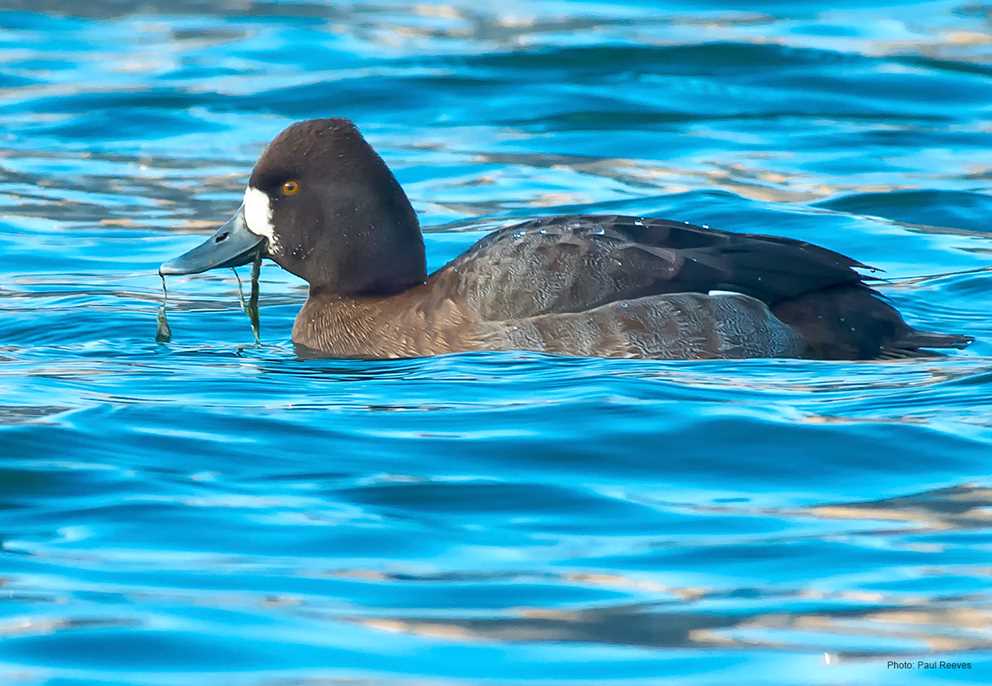Overview
The Lesser Scaup is a medium-sized diving duck found only in North America. Males are known for their blue bills (they are often called “blue bills”) in conjunction with their black heads, which may show iridescent tones of blue, purple, or green depending on light angles, while females appear brown with a noticeable white patch at the base of the bill. In flight, both sexes display bold white stripes on their secondary feathers. They primarily breed in freshwater boreal wetlands across western Canada and Alaska and migrate to the Great Lakes and coastal bays and marshes in winter.
Description
Key Identification Features:
- Pale blue bill with a black nail marking in the center.
- Males have a striking black head which may show iridescent colors in light.
- Females have a white patch at the base of the bill, but unlike ringnecks, have no white ring on the bill itself.
- Notable white stripe on secondary feathers in flight.
Male Identification:
-
Breeding Plumage: Males have a black head, neck, and breast, with iridescent tones of blue, purple, or green depending on the light. The head may appear peaked, though this can be inconsistent. Their pale blue bill features a black nail, and their iris is yellow to golden. The back and sides are white with black/gray vermiculation, and the belly is white.
-
Basic Plumage: Dull brownish-gray with a dull gray-blue bill, typically attained in summer (July/August) during molt.
Female Identification:
-
Females are shades of brown with a white patch at the base of their blue-gray bill that has the same black nail as males. Unlike ringnecks, they have no white ring on the bill itself. Both breeding and basic plumages are similar, though the white patch may be less noticeable in the basic plumage. Females also have white belly feathers.
In-Flight Identification:
-
Male: In flight, males have a black head, neck and breast; head may show iridescent tones of dark blue, purple, or green depending on angle of light. They display a bold white stripe on their secondary feathers, which does not extend into the primaries.
-
Female: Darker brown heads with lighter brown neck and white belly feathers. Similar to males, females also show the white stripe on secondary feathers during flight.
Vocalizations:
-
Males are typically quiet but may give a “whee-oooo” call during courtship.
-
Females emit a purring “b-r-r-r-r-rp” in flight and a harsh “scauuup” as an alarm call.
Similar Species:
-
Greater Scaup: Greater Scaup show a rounder, larger head, a wider bill, and a white stripe extending into the primary feathers in flight.
-
Ring-necked Duck: Ringneck males have more uniform black back and uniquely patterned white on flanks. Male and female ringnecks have a prominent black tip and white ring on the bill in contrast to the nearly uniform bluish bill in lesser scaup.
Habitat Preferences
Lesser Scaup favor deeper, permanent to semi-permanent wetlands in boreal and prairie regions during the breeding season. These wetlands often have abundant emergent vegetation, providing ideal nesting grounds. Lesser Scaup also uniquely nest in upland grass or sedge areas.
During migration and in winter, they are typically found on larger bodies of water such as the Great Lakes, brackish coastal bays, and nearshore marine waters. They rely on these habitats for food sources like small mussels and clams. Recently, overwinter concentrations of lesser scaup have increased in the Great Lakes, owing to warmer winters and proliferation of invasive zebra mussel populations.
Key Habitat Types:
- Breeding: Freshwater boreal wetlands and prairie wetlands.
- Migration and Wintering: Great Lakes, coastal bays, larger lakes and rivers, nearshore marine environments.
Foraging Habits and Diet
- Breeding Season: Primarily feed on amphipods and aquatic invertebrates in boreal wetlands.
- Migration and Winter: Diet shifts to include small mussels and clamsincluding invasive zebra mussels in the Great Lakes.
Breeding Habits
- Monogamy: Seasonally monogamous, forming new pair bonds each year, usually in late spring.
- Nest Locations: Nest on the ground in areas of grass or sedge, or over water in emergent vegetation.
- Clutch Size: 6 to 14 eggs, with an average of 8 to 9. Eggs are dark olive-buff and elliptical in shape. Incubation lasts around 26 days.
Migration & Distribution
- Fall Migration: Lesser Scaup are among the latest waterfowl to leave their northern breeding grounds, departing in moderate to large flocks in late October or November, with peak numbers arriving in wintering areas in mid-December to February. Migration is often nocturnal and associated with post-cold front northerly tail winds.
- Spring Migration: Spring migration starts as early as February, with birds reaching breeding areas from mid-April to mid-May. Important staging areas include the Great Lakes and Upper Mississippi River navigation pools.
- Changing Patterns: Warmer winters and abundant zebra mussels have led some Lesser Scaup to winter longer in the Great Lakes.

Conservation Status
- IUCN Status: Listed as "Least Concern" by the IUCN.
- Population Status: Breeding population declined from an estimated six million in the 1970s to around four million today.
- Conservation Concerns: Threats include habitat degradation in Western Boreal Forest, declines in quality and quantity of food resources in migration and wintering regions, exposure to contaminants, and lower female survival rates.
- Conservation Focus: Efforts center on protecting intact boreal wetlands and enhancing the quality of wetlands serving as spring staging habitat.
Harvest Information
- An average of 128,118 lesser scaup were harvested across the US during the 2021–22 and 2022–23 hunting seasons.
- Lesser scaup harvest is typically highest in the Mississippi Flyway, accounting for 40 to 50 percent of the total US harvest.
- The top three harvest states for lesser scaup across the 2021–22 and 2022–23 hunting seasons were Texas (15,817), Louisiana (15,180), and California (10,588).



